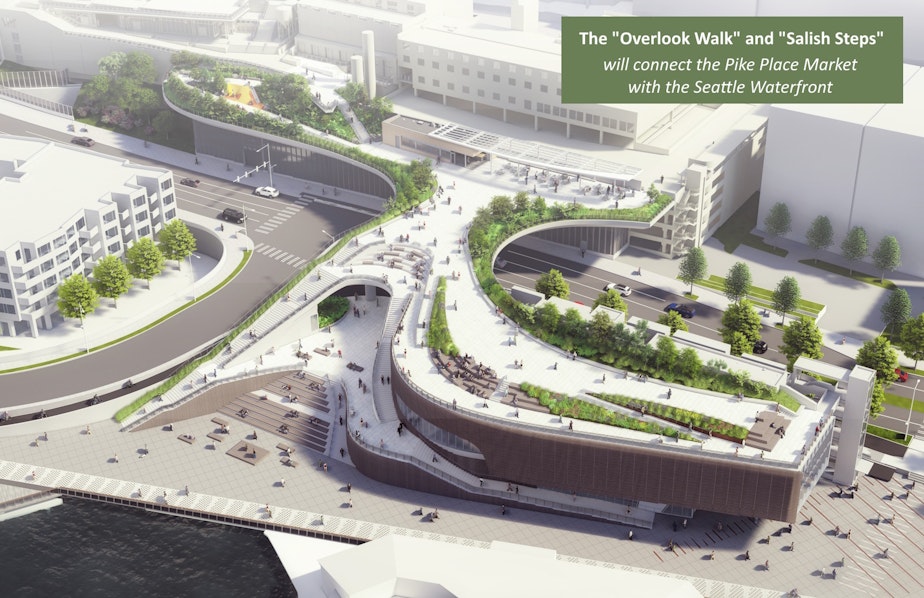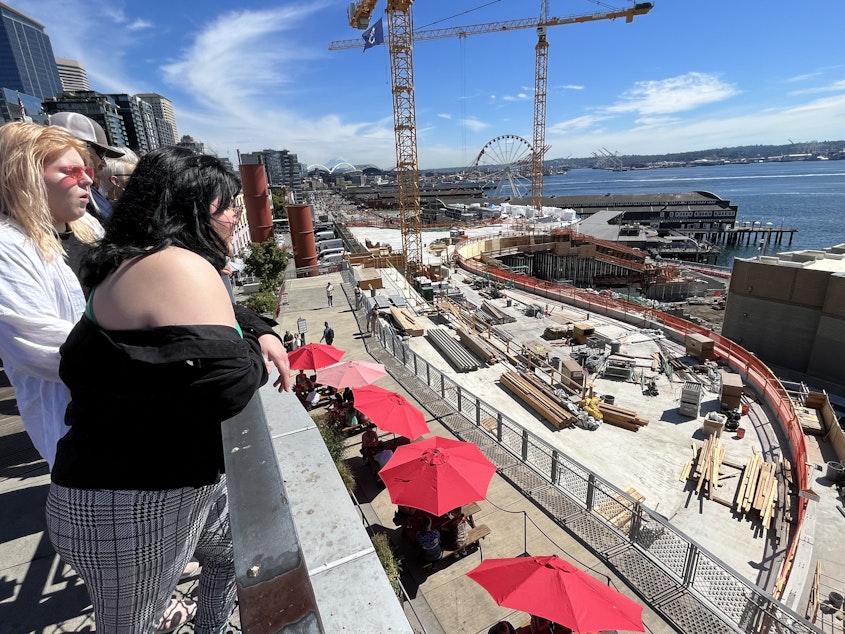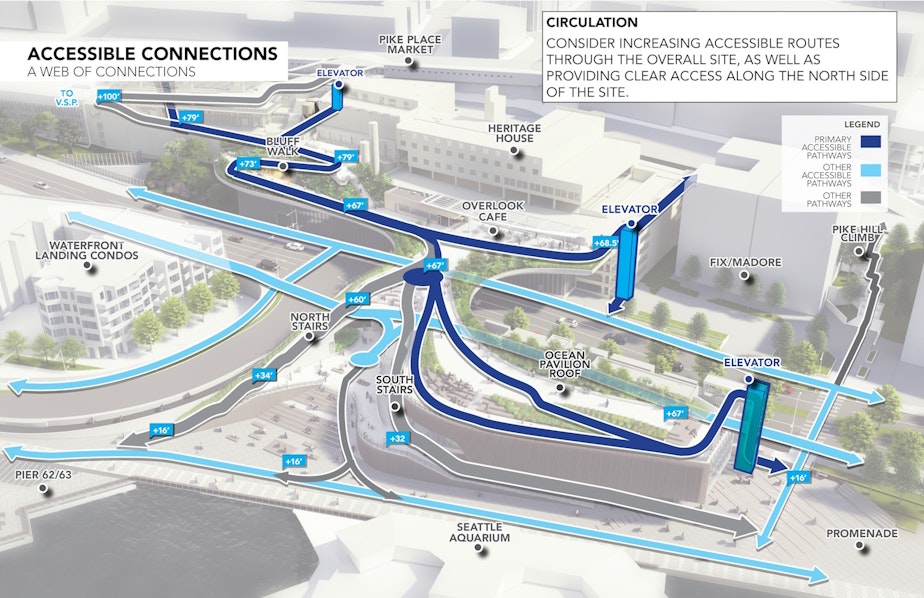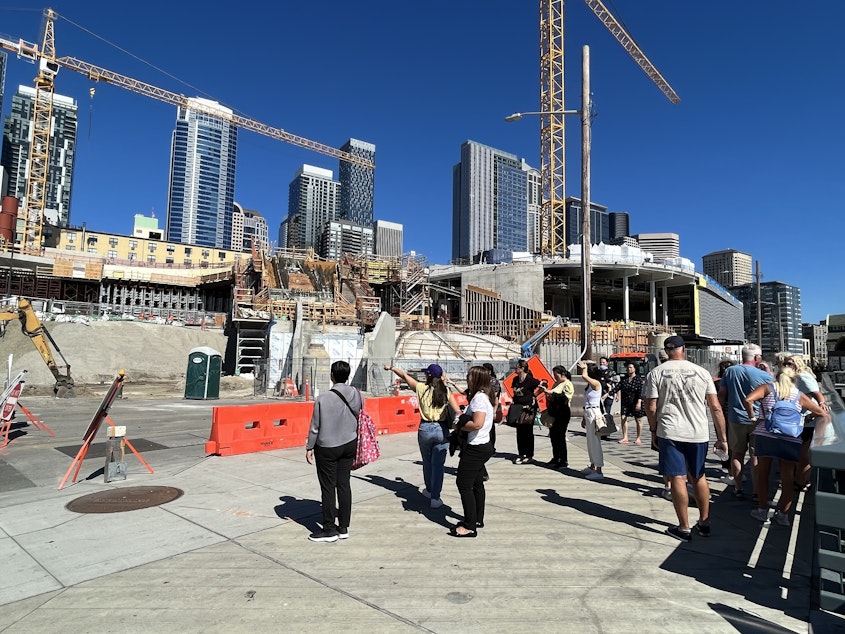A guided tour of Seattle's new waterfront

The Alaskan Way Viaduct drew a distinct line between Seattle's waterfront and the rest of the city. Now, the viaduct is gone.
Completed in 1959, the double decker freeway was viewed by many as a barrier. There were even discussions of replacing it as early as the '60s.
The writing was on the wall after the Nisqually quake in 2001. Fears about another earthquake helped propel a ballot measure to replace the viaduct with a deep-bore tunnel, sending drivers under the city instead of above it.
Now, the elevated highway is gone and construction continues on a massive overhaul of Seattle’s waterfront, expected to be completed sometime in 2025.
We’re two years away from that deadline. KUOW’s growth and development reporter Joshua McNichols sat down with Soundside host Libby Denkmann to talk about his recent check in on the progress at Seattle's waterfront.
RELATED: Seattle Aquarium can borrow money to complete waterfront addition
Sponsored

A lot of drivers are taking the tunnel these days when they have to cross under downtown Seattle, but if you haven't spent much time on the waterfront lately, you may not know that there have been a lot of changes.
As Joshua McNichols describes, "there's like three quarters of a billion dollars worth of changes down there."
Currently, the 'highway' is still taking up four lanes of traffic, and the landscaping hasn't been planted yet to separate pedestrians from the road, but it's all getting there.
Joshua's tour was guided by Angela Brady, the Civic Projects Director for the Office of the Waterfront.
Sponsored
"We're really focused on the pedestrian promenade," Brady explained. "Which is the linear park that extends the entire length of the waterfront, essentially. And just in total, we're building about 20 acres of public open space and park along the waterfront."
The purpose of all the landscaping and greenery will be to provide a wide berth between vehicle and foot traffic along the waterfront, especially with cars queuing for the ferries at Colman Dock.
"If you're a pedestrian, you're walking along along the water's edge, you're gonna be pretty far away from these vehicles on that side," Brady said. "The landscaping is going to block all that out. This will really start feeling like a park sometime early next year, people are going to start seeing some of that come in."
Another thing that impressed Joshua was the fact that they're building a public restroom.
"This is not a huge restroom," he said. "It's going to have six gender-neutral private stalls, but it's going to be staffed. But it's better than what's there now, which is basically nothing."
Sponsored
The Seattle Aquarium is also getting a new expansion, which includes an "oculus," where you can look up into the coral reef tanks from the walkway below the building.
On top of the building however, is something completely different.
The rooftop deck will connect with Overlook Walk, connecting Pike Place Market to the waterfront via a system of staircases and elevators.

Civic Projects Director Angela Brady was very excited about this part of the construction:
Sponsored
"Let's say you want to just kind of hang out and relax and see some of the views over the sound. You'll be able to walk out to the market front, which will connect into this new elevated park called the Overlook Walk. It'll be landscaped, it'll have some amazing gardens, it'll have art, it'll have places for people to just sit and do whatever it is they want to do up there. It'll have a café space as well. So if you want to grab a cup of coffee, or an iced tea or something and sit up there for for an hour or two, it's just gonna be a lovely, amazing space."
The part of Overlook Walk that impressed Joshua McNichols most? The Salish Steps.

"I feel like the name that they're using to describe it, "The Salish Steps," it reminds you of the Spanish Steps in Rome," McNichols explained. "You basically have ornamental steps and then a big beautiful landing, then ornamental steps and a big beautiful landing. This is kind of like that. There's all kinds of places for people to gather. I imagine, we'll see all kinds of activity on those steps."
For all of the interesting things being built, and the focus on foot traffic, there are still questions about the four-lane highway running through the center of the area.
Sponsored
Back in May, former Seattle Mayor Mike McGinn, tweeted a photo of the newly opened Elliott Way connector, with the caption "So we just rebuilt the highway?"
Joshua McNichols understands what he was saying.
"There is a tension between the sort of highway function of this new waterfront space, and the parks parts of it."
We just have to wait for construction to be completed to see how it all shakes out. But as Joshua McNichols points out: "This is a major public space that we are adding to downtown Seattle, at a time when, who downtown is for, and who its public spaces are for, is sort of in flux.
And that's a matter of constant discussion and reinvention right now, right? The mayor wants more people to move downtown, and more people are moving downtown. But there's more discussion of how to make places where they can act as living rooms for people who live in small apartments downtown. So that's one kind of use that the waterfront could serve.
Another kind of use is for tourists. We have lots of tourists coming through right now, and they're, in a lot of ways, helping sustain the downtown economy right now. So that's another kind of user.
And then there are people who have special needs and needs for services, who need places to hang out and places to go, including unhoused people.
Sometimes people can perceive rightfully or wrongly, these needs to be in conflict. So as we unveil and complete this major public space on the waterfront, we'll begin to see told in the story of sort of how it's policed, and how it's monitored, and who goes there, who it is for."
You can listen to the entire conversation in the audio above, and we'd love to know what you think about the new waterfront construction. Send us an email - soundside@kuow.org or leave a voicemail at 206-221-3213.






